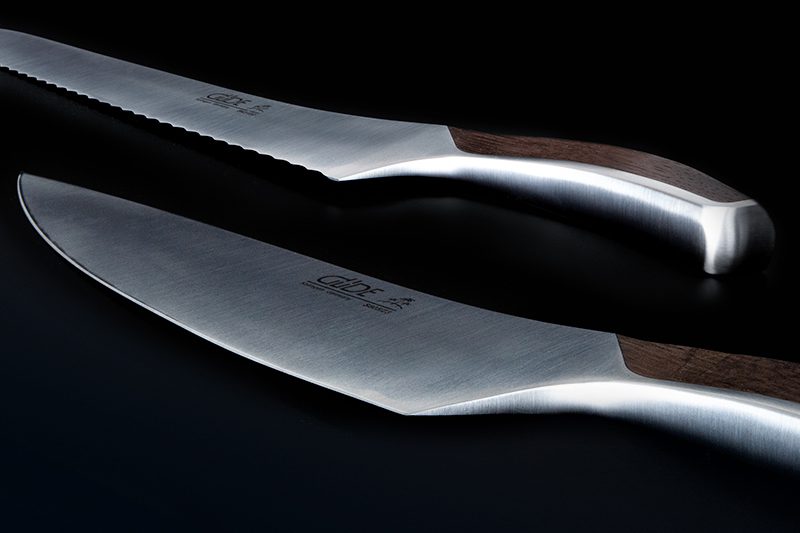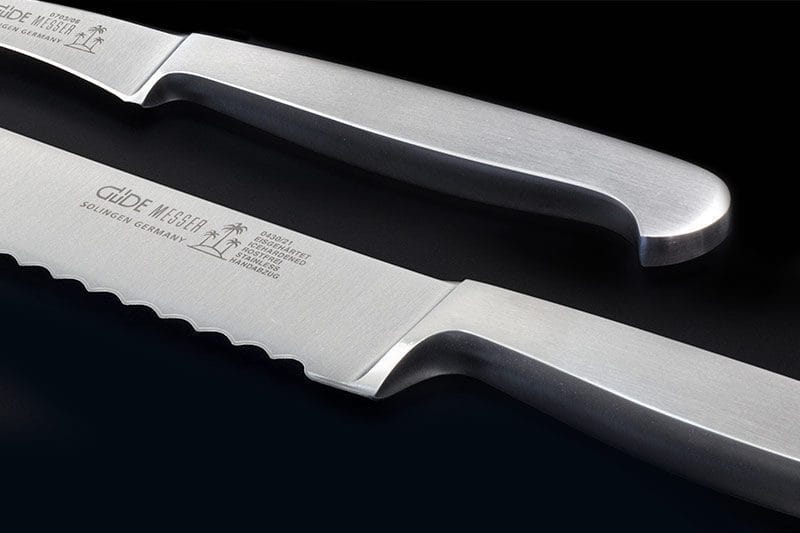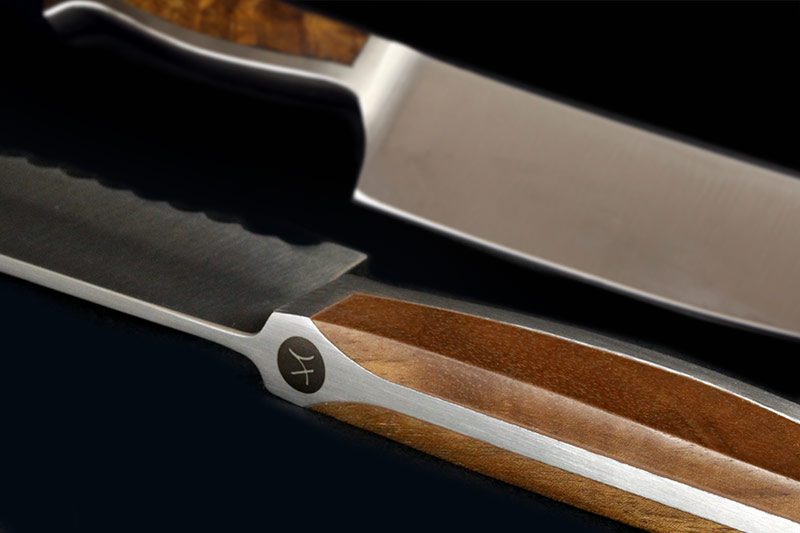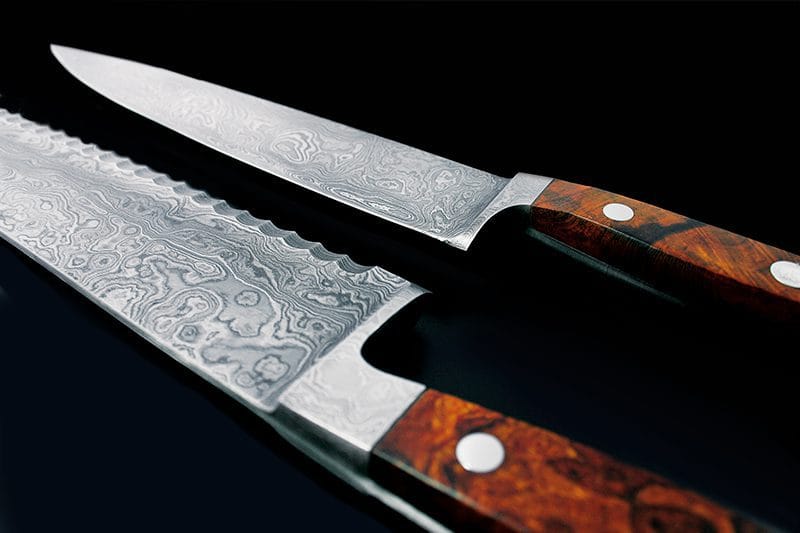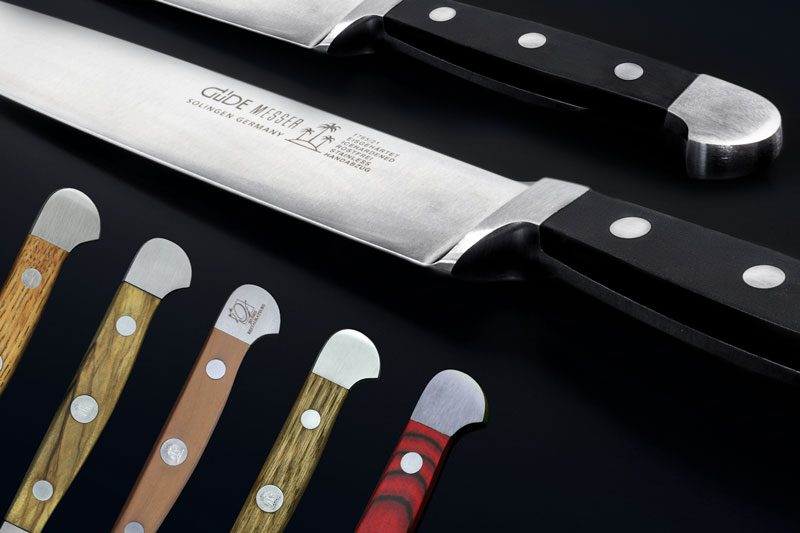BRICCOLE DI VENEZIA
The handle scales are made of the oak wood of Venetian gondola poles (briccole). These poles are replaced every 100 years. And so some of these stakes found their way to Solingen in the knife manufactory of GÜDE. This special edition, limited to four knives, brings the incomparable flair of the Italian lagoon metropolis into the kitchen.
Like all the knives in the Alpha series, the blade of the Briccole di Venezia series is hand-forged from one piece of chrome-vanadium-molybdenum knife steel. More than 40 further manual operations by hand are necessary to produce a unique piece of Solingen knifemaking art. Due to the wooden handles, these knives should not be put in the dishwasher. The blade is stainless, ice-hardened and of course hand-sharpened.


Material
The blade material of knives must sometimes fulfil contradictory requirements. It is therefore crucial to weigh up the different requirements and ensure an optimum. On the one hand, the knife steel should be hard, but not too hard, otherwise there is a risk that the blade will break under heavy use. On the other hand, the knife steel should also not be too soft, as the knife would lose its sharpness too quickly in use due to constant wear. That is why the knives in the Briccole di Venezia series from GÜDE are made of a chrome-molybdenum-vanadium knife steel. This steel perfectly meets the sometimes contradictory requirements with an optimum hardness of approx. 57-58 HRc (Rockwell).
The hardness of the knife steel of the Briccole di Venezia series of 57-58 HRc is not too hard and not too soft for the different requirements that a good knife must meet.
Such a degree of hardness makes the blade of knives from the Briccole di Venezia series torsionally stiff, thus guaranteeing precise guidance of the knife and thus a precise cut. But even a hard steel, such as the GÜDE knife steel, can be ground very thin. In this way, even a hard steel can be very flexible.
Production
All knives in the Briccole di Venezia series are traditionally drop-forged - from one piece of steel. The result of this traditional technology of drop forging is a particularly high material strength even when the knife is subjected to dynamic stresses. During the forging process, the entire forging blank is heated in the die until it glows red and is then deformed between the two dies, the upper and lower die. In further detail-oriented manual work steps, the drop-forged blank is turned into a unique piece from the knife manufactory GÜDE - handmade.
After they have been forged, the knives are stamped out of the forging blank and then roughly ground, calibrated and cleaned. This is followed by so-called ice-hardening: the knives are cooled to -80 °C to improve the structure of the microstructure in the blade steel. In the next step, the knives are tempered in two stages. Tempering is a term used by the knife makers in Solingen. Tempering means that the knife is heated again and thus made unbreakable. Now the blade is pre-ground. This is followed by the pre-grinding of the back of the knife, which is the upper part of the knife. This is followed by the fine grinding of the back of the knife and the sharpening of the bolster. The Solingen knife makers call the bolster the thickening between the blade and the handle and at the end of the handle. The insides of the two handle half-shells are now pre-ground. Pre-grinding the front and rear bolsters takes another 5 steps. Only then can the blade be fine-ground. The Solingen knifemaker also calls this "pliesten". This gives the blade its distinctive surface. The special GÜDE serrated edge is now applied to the bread knives. The handle scales made from the wood of Venetian gondola poles with their distinctive grain are now fitted to the left and right of the knife handle. Then the holes for the rivets are drilled. A countersink must be drilled in the holes for the rivet heads. The two wooden handle scales and the tang made of the GÜDE blade steel are now firmly joined together with rivets. Another five or so operations are required to roughly grind the handle scales to the tang and the front and rear bolsters so that the transitions between wood and steel are smooth. These five steps must then be repeated with a finer abrasive belt. Now the upper part of the knife, the back, gets its fine grinding. This is followed by the finest grinding of the front bolster. Then the knife handles are pre-polished. The central decorative rivet is inserted and the handles are finely polished. Only now does the knife get its sharpness trigger, because the knife edge, also called the bevel, is now sharpened (the knifemaker calls this "honing"). The trigger is polished so that the blade slides better through the material to be cut. In the next step, the GÜDE logo is etched onto the blade. Cleaning and quality control are the final operations. After that, the knives receive a sheath for protection. Last but not least, the shipping bags are provided with rivets and the labels belonging to the series and the blade type. The finished knives are now stored and ready for shipping.
Form
The technology of forging in the die creates degrees of freedom in the design language. From the end of the handle to the tip of the knife, shapes can be realised that would not be feasible in any other forging technology. Thus, a design language like that of Alpha is only possible in the drop forging process. This explains impressively why GÜDE has remained true to this proven and traditional technology since its founding in 1910, now in its fourth generation.
An unmistakable feature of many series from the knife manufacturer GÜDE is the typical double bolster. Kropf is the Solingen knifemakers' term for the thickening of the blade steel that is achieved during forging. The (front) bolster between the blade and the handle protects the fingers and also serves as a balance weight.
The additional bolster at the end of the handle gives the knives of the Briccole di Venezia series their balance. For the user, this means: pleasant and fatigue-free work at the same time.
The term tang refers to the part of the steel to which the two handle scales of the Briccole di Venezia series are attached on the left and right. When the tang goes from the blade to the end of the handle, it is called a full tang. All knives in the Briccole di Venezia series from GÜDE have a full tang, which gives the knives a better balance of weight.
Visible over the entire length of the handle, both from above and below, the full tang is proof that the knives in the Briccole di Venezia series are forged in one piece. No material transition, no seam - just as it must be with a knife that has been drop-forged from one piece.
Function
A good knife should not only be sharp, it should also stay sharp for as long as possible. A good knife should also lie well in the hand and be balanced so that fatigue-free and safe work is guaranteed at all times.
Sharpness and edge retention of the Briccole di Venezia series are ensured both by the optimum hardness of the GÜDE blade steel with approx. 57-58 HRc (Rockwell) and by the GÜDE bevel angle of approx. 33 degrees. The shape of the handle, the full tang and the double bolster typical of GÜDE make the knives in the Briccole di Venezia series a reliable tool that guarantees perfect handling and balance.
Sharpness and edge retention are determined not only by the blade material but also by the bevel angle: cutting is like driving a wedge through a material to be cut. The more acute the angle of the wedge, i.e. the bevel angle, the easier it is to drive the wedge through the material to be cut. The term "bevel" is the term used by Solingen knifemakers for the cutting edge, i.e. the sharply ground part of a knife. An acute bevel angle makes a knife sharper than a blunt bevel angle. If the bevel angle is too acute, however, the bevel can break. That is why the knives in the Briccole di Venezia series from GÜDE have an optimum bevel angle of approx. 33 degrees. This angle guarantees both sharpness and stability. The chrome-molybdenum-vanadium blade steel of the Briccole di Venezia series guarantees long-lasting sharpness with its hardness of approx. 57-58 HRc (Rockwell). It is important to always cut on a suitable cutting surface, e.g. wood or plastic. The almost proverbial balance of the knives in the Briccole di Venezia series is a result of the double bolster in combination with the full tang, which creates a counterweight to the blade in the area of the handle. For the user this means: Perfect balance and fatigue-free work with a secure grip at all times. The front and rear bolsters enclose the hand and protect it from slipping, even when greater force is applied.
The knives in the Briccole di Venezia series deliver what knife lovers expect from a perfect knife. Handcrafted, drop-forged from a single piece, with the experience of centuries of Solingen knifemaking.





